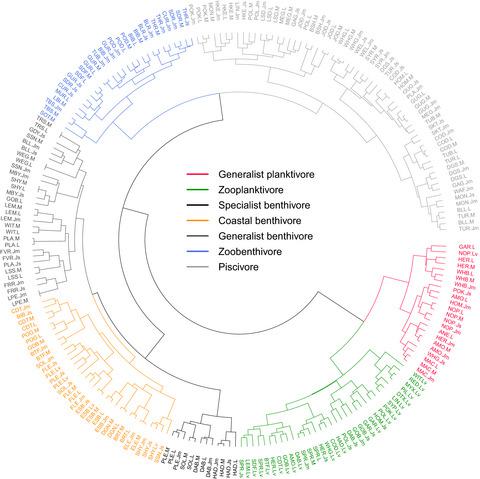当前位置:
X-MOL 学术
›
J. Appl. Ecol.
›
论文详情
Our official English website, www.x-mol.net, welcomes your
feedback! (Note: you will need to create a separate account there.)
A feeding guild indicator to assess environmental change impacts on marine ecosystem structure and functioning
Journal of Applied Ecology ( IF 5.0 ) Pub Date : 2020-06-28 , DOI: 10.1111/1365-2664.13662 Murray S. A. Thompson 1 , Hugo Pontalier 1 , Michael A. Spence 1 , John K. Pinnegar 1 , Simon P. R. Greenstreet 2 , Meadhbh Moriarty 2, 3 , Pierre Hélaouët 4 , Christopher P. Lynam 1
中文翻译:

一个进食行会指标,用于评估环境变化对海洋生态系统结构和功能的影响
更新日期:2020-06-28
Journal of Applied Ecology ( IF 5.0 ) Pub Date : 2020-06-28 , DOI: 10.1111/1365-2664.13662 Murray S. A. Thompson 1 , Hugo Pontalier 1 , Michael A. Spence 1 , John K. Pinnegar 1 , Simon P. R. Greenstreet 2 , Meadhbh Moriarty 2, 3 , Pierre Hélaouët 4 , Christopher P. Lynam 1
Affiliation

|
- Integrating food web indicators into ecological status assessments is central to developing effective management measures that can improve degraded ecosystems. This is because they can reveal how ecosystems respond to environmental change that cannot be inferred from studying habitat, species or assemblages alone. However, the substantial investment required to monitor food webs (e.g. via stomach contents analysis) and the lack of internationally agreed approaches to assessing them has hampered their development.
- Inventories of trophic interactions have been collated world‐wide and across biomes, and can be applied to infer food web structure and energy flow. Here, we compile a new marine dataset containing 8,092 unique predator–prey interactions from 415,294 fish stomachs. We demonstrate how feeding guilds (i.e. groupings based on diet and life stage) could be defined systematically and in a way that is conducive to their application internationally across ecosystems; and apply them to the North Sea fish assemblage to demonstrate their responsiveness to anthropogenic pressures.
- We found evidence for seven distinct feeding guilds. Differences between guilds were related to predator size, which positively correlated with piscivory, phylogeny, with multiple size classes of a species often in the same guild, and habitat, as pelagic, benthic and shallow‐coastal foraging was apparent.
- Guild biomasses were largely consistent through time at the North Sea‐level and spatially aggregated at the regional level with change relating to changes in resource availability, temperature, fishing and the biomass of other guilds. This suggests that fish biomass was partitioned across broad feeding and environmental niches, and changes over time were governed partly by guild carrying capacities, but also by a combination of covariates with contrasting patterns of change. Management of the North Sea ecosystem could therefore be adaptive and focused towards specific guilds and pressures in a given area.
- Synthesis and applications. We propose a food web indicator which has been explicitly called for to inform policy via food web status assessment as part of the European Union's Marine Strategy Framework Directive and the indicator toolkit supporting The Convention for the Protection of the Marine Environment of the North‐East Atlantic (the ‘OSPAR Convention’).
中文翻译:

一个进食行会指标,用于评估环境变化对海洋生态系统结构和功能的影响
- 将食物网指标纳入生态状况评估对于制定可以改善退化的生态系统的有效管理措施至关重要。这是因为它们可以揭示生态系统如何应对仅通过研究栖息地,物种或组合而无法推断出的环境变化。但是,监测食物网所需的大量投资(例如,通过胃内容物分析)以及缺乏国际认可的评估方法都阻碍了食物网的发展。
- 营养相互作用的清单已在全世界和整个生物群落中进行了整理,可用于推断食物网的结构和能量流。在这里,我们编译了一个新的海洋数据集,其中包含来自415,294条鱼胃的8,092种独特的捕食者与猎物之间的相互作用。我们演示了如何系统地定义喂养行会(即基于饮食和生命阶段的分组),并有助于它们在整个生态系统中的国际应用;并将其应用于北海鱼群,以证明其对人为压力的反应能力。
- 我们发现了七个不同的喂养行会的证据。行会之间的差异与捕食者的大小有关,这与食肉动物,系统发育和同一个行会中通常存在于同一个行会中的多种大小类别正相关,而上层,底栖和浅沿海觅食则是明显的。
- 在北海水平,行会生物量在时间上基本保持一致,在区域一级在空间上聚集,其变化与资源供应,温度,捕鱼和其他行会生物量的变化有关。这表明鱼类生物量被划分为广泛的摄食和环境生态位,并且随着时间的变化部分受行会的承载能力控制,还受协变量和变化模式的共同影响。因此,北海生态系统的管理可以是适应性的,并着眼于特定地区的特定行会和压力。
- 综合与应用。我们提出了一个食物网指标,作为欧盟《海洋战略框架指令》和支持《保护东北大西洋海洋环境公约》的指标工具包的一部分,明确要求通过食物网状态评估为政策提供信息(“ OSPAR公约”)。









































 京公网安备 11010802027423号
京公网安备 11010802027423号